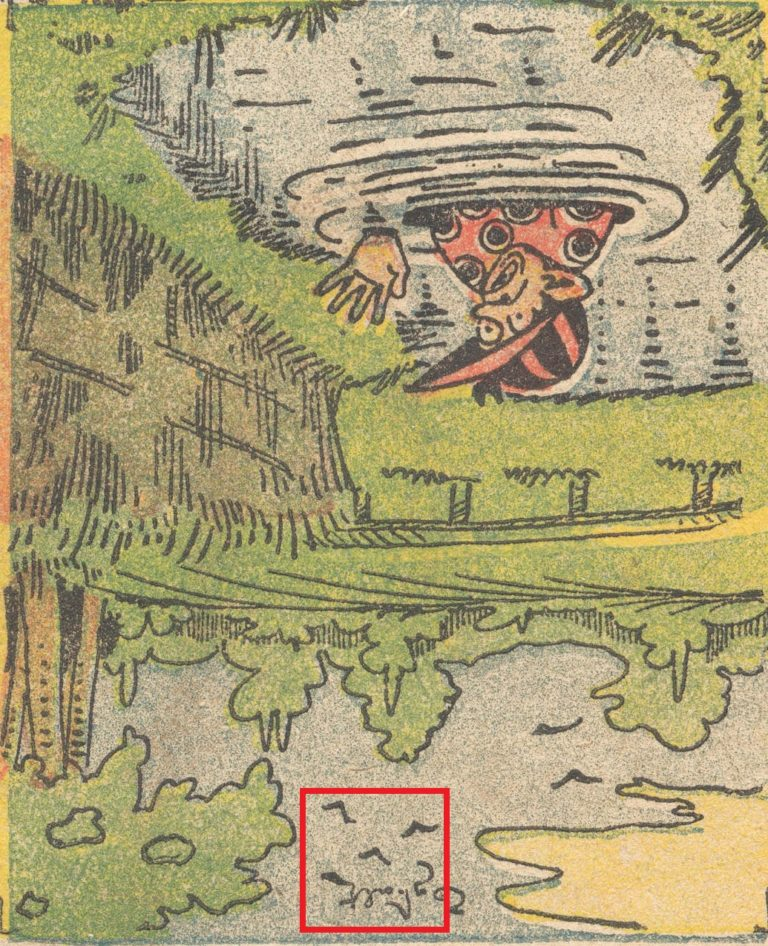A riddle to wake up your attention to detail
At a glance, this old illustration looks whimsical: a man flailing in water, trees and reeds on the bank, a hazy sky above. Nothing too dramatic—until you’re told, “There is a great danger awaiting the man in the photo. Find it!” Suddenly the scene turns into a mystery. What danger? Where is it hiding? Is it in the murky water, the brush along the shore, or the sky overhead?
Before you scroll, take thirty seconds to study the picture carefully. Let your eyes wander slowly from the top-left corner to the bottom-right. Which objects feel natural, and which feel odd? If you were in the man’s position, what would you fear most?

Now that you’ve taken your first pass, let’s talk about why puzzles like this can stump even sharp observers—and how to beat them.
Why these picture riddles trick even careful readers
“Find the danger” puzzles are built on a few reliable psychological quirks:
- We see what we expect. Our brains are masters of filling in gaps. In a pastoral landscape, we expect birds in the sky, ripples in the water, and scribbly foliage. When something disguised looks like one of those expected elements, we breeze past it.
- Motion and faces hijack attention. We zero in on the flailing man first (movement, expression, a human face) and neglect quiet, static corners of the frame—exactly where artists love to hide the truth.
- We skim, not scan. Most of us do a quick sweep. Riddle designers know this. They hide the clue in a place you’ll glance at—but not interrogate.
- We hunt the dramatic and miss the subtle. We search for teeth in the water, a lurking shadow, or a sinister silhouette behind a tree, while the actual answer may be a tiny typographic trick.
Recognizing those traps is half the game. The other half is adopting a calm, methodical approach.
Video : 12 Riddles to Check if You Can Escape from Dangers
A step-by-step method to uncover hidden threats
Use this simple routine for any “spot the danger” scene:
- Grid the image mentally. Divide it into four or six zones. Promise yourself you’ll inspect each zone before deciding.
- Check the “ordinary” textures. Sky scribbles, water ripples, grass strokes, and bird shapes are perfect camouflage for secret messages.
- Look for orientation games. Artists love flips, mirrors, and rotations. If a cluster of marks feels decorative, ask: “What if I viewed it upside down?”
- Trace edges and contours. Follow lines with your eyes: the bank, the clouds, the treetops. When a contour suddenly behaves like handwriting rather than scenery, you’ve found a tell.
- Confirm with a second modality. If something might be a letter, try reading it aloud. Sound often reveals meaning faster than sight alone.
Let’s apply that approach to this image together.

Zone-by-zone analysis
- Foreground (water and the man). The man’s face tells a comic story of surprise. The ripples around him are circular and consistent. Nothing here screams “predator” or shows an obvious shadow beneath the surface. That doesn’t mean the water is safe—only that the illustrator isn’t exposing the threat here.
- Right bank and trees. Heavy crosshatching builds the embankment; foliage is drawn with typical blobby outlines. It all matches the drawing style. No hidden jaws or eyes peek through the leaves.
- Middle distance (fence line and meadow). Receding lines behave properly; nothing is misshapen or doubled. So far, no smoking gun.
- Sky and cloud area. Now we arrive where many people stop looking carefully. The top of the frame features scattered V-shaped “birds” and stray specks—just the sort of marks our brains dismiss. But scan the area inside the red box. The marks there feel… strangely intentional. The curves seem to hook and loop like handwriting rather than random strokes. It’s as if the sky is whispering something.
The crucial move most solvers skip
This is where Step 3—orientation—earns its keep. What happens if you rotate the picture 180 degrees? Yes, flip it fully upside down. (If you’re on a phone, turn the device. If you’re on a laptop, rotate the image. Even tilting your head can help.)
Once inverted, study the red-boxed sky again. Those “bird” shapes and squiggles suddenly align into letters—not doodles. The cluster resolves into a single, urgent word.
Answer (spoiler): when the illustration is flipped upside down, the ink strokes inside the red box resolve into the word “GATOR!”—a hidden warning that an alligator is nearby and the man in the water is in serious danger.

This trick works because the illustrator crafted each stroke to carry two meanings: as innocent birds when viewed normally, and as legible letters when the scene is turned over. We miss it because our brains default to the first, more ordinary interpretation.
Why the solution feels so satisfying
- It rewards thoroughness. Instead of rewarding a lucky glance, the puzzle pays off when you commit to a systematic search.
- It flips expectation—literally. The danger isn’t in the water; it’s in the sky, and only visible after you invert the scene.
- It teaches a reusable habit. From now on, when a puzzle doesn’t budge, you’ll remember to try a rotation. That one habit solves a surprising number of visual riddles.
A quick checklist for your next visual riddle
Keep this mini-toolkit handy:
- Scan every zone; don’t fixate on faces or action.
- Question the “filler” textures—sky strokes, birds, grass hatching, water ripples.
- Try a 180° flip (and sometimes a mirror flip).
- Look for letter-like rhythm: repeated ascenders/descenders, dots like “i,” tails like “g,” crossbars like “t.”
- Read what you think you see out loud. If it sounds like a word, you’ve cracked it.
Video : 🍿😲 Can You Spot the Hidden Danger? | Viral Puzzle Game Challenge 🔥
Your turn—join the hunt
Did you catch the hidden word before the flip? How long did it take you to find it? Which area distracted you most—the man’s expression, the vortex of water, or the dense foliage? Drop your experience in the comments. Tell us whether you first suspected the water (most people do!) or if you were drawn to the sky immediately. If you used a particular strategy—like covering parts of the image with your hand to force focus—share it so others can try it too.
And if you’re reading this with friends or followers, challenge them: no flipping for thirty seconds. Set a timer, then allow the rotation. The “aha!” moment is half the fun.
Why keep practicing with puzzles like this
Beyond entertainment, these riddles sharpen skills you use every day: careful reading, proofing, layout review, even risk spotting. You learn to slow down, test assumptions, and verify details—habits that pay off when you evaluate a contract, scan data tables, debug a design, or simply notice that something at home is out of place.

Think of each puzzle as a mini-workout for your brain’s “attentional muscles.” The more you train, the faster you’ll catch anomalies others miss.
Wrap-up: from guesswork to evidence
The scene begins as a pastoral cartoon and ends as a crisp lesson in observation. The danger isn’t a shadow in the reeds or a ripple in the pond. It’s a hidden word—a warning spelled right above our heads, visible only when we flip the drawing. If you found “GATOR!” on your own, take a bow. If the flip trick revealed it, store that strategy in your toolkit.
Now, keep the momentum going. Try another visual riddle, apply the same step-by-step method, and challenge yourself to uncover the twist without hints. Your logic, focus, and patience will level up with every puzzle you tackle.